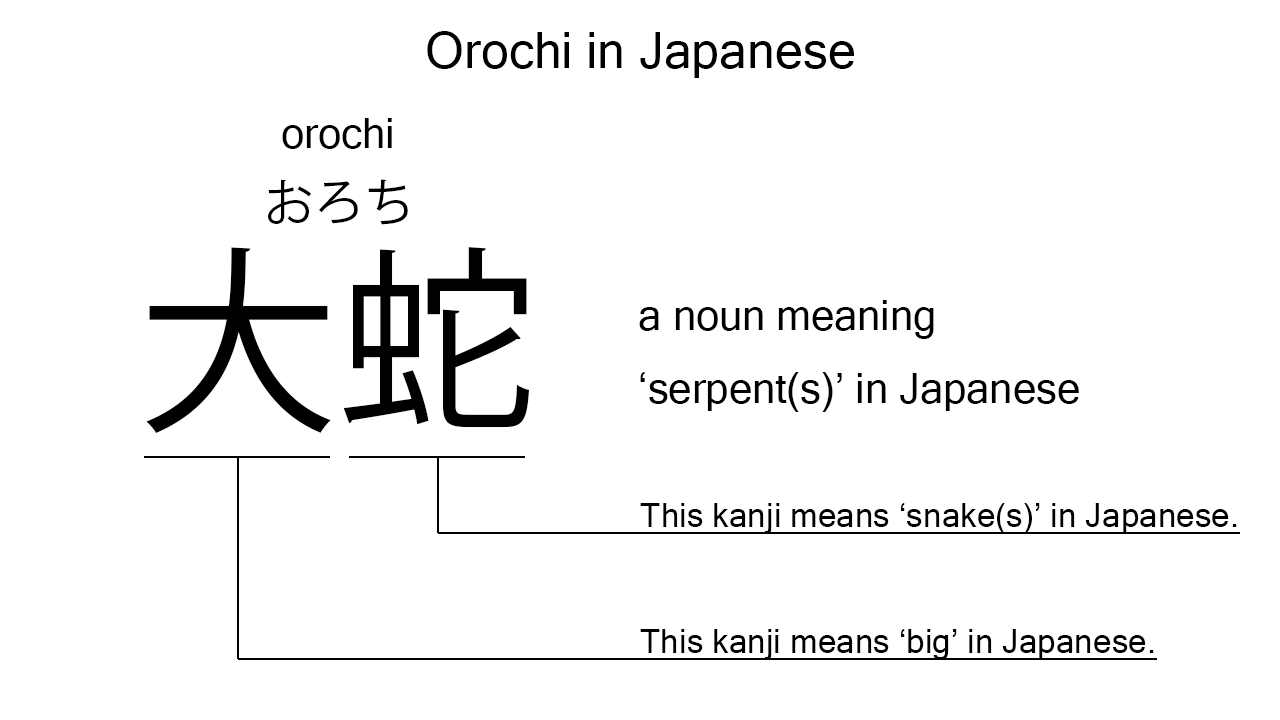What does “orochi” mean in Japanese?
Native speakers say “orochi” to mean ‘serpent’ in Japanese. Perhaps, some Japanese learners know this word as it is sometimes used in Japanese movies, novels, manga, anime, and the like. In this blog post, however, I will explain this word in detail based on its kanji expression. And also, I will explain how to use it through example sentences. My explanations would help Japanese learners understand “orochi” more clearly. Then, let’s get started!
Contents
Definition and meanings of “orochi”
Let me start with the definition and meanings of “orochi”.
- orochi – 大蛇 (おろち) : a noun meaning ‘serpent’ or just ‘big snake’ in Japanese. This can also work as plural. Learn more about Japanese plural.
The definition and meanings are simple and clear, I think. To understand this noun more clearly, however, let me explain its kanji characters in detail, one by one.
What does “orochi” literally mean in Japanese?
The kanji expression of “orochi” consists of the following two kanji characters:
- 大 : a kanji character used to mean ‘big’, ‘large’, or such in Japanese.
- 蛇 : a kanji character used to mean ‘snake’ in Japanese.
These two kanji characters tell us that “orochi” literally means a ‘big snake’ in Japanese. What the kanji characters express is, therefore, completely in line with the actual meanings.

When we meet new kanji expressions, we should check their kanji characters in detail to understand their meanings clearly and deeply. In many cases, kanji characters tell us a lot about the meanings of the expressions they form. Actually, here, we could get the better understanding of “orochi” through the detailed kanji check above.
So far, I’ve explained the definition and meanings of “orochi” together with its kanji characters. Then, let me explain how to use it through the example sentences below.
Example #1: how to say “serpent” in Japanese
kono kuni ni orochi ga i ta – この国に大蛇が居た (このくににおろちがいた)
There was a serpent in this country.
Below are the new words used in the example sentence.
- kono – この : a determiner used before a noun which refers to something close to the speaker. In the example, this is used before “kuni” to say “this country” in Japanese.
- kuni – 国 (くに) : a noun meaning ‘country’ in Japanese. This can also work as plural.
- ni – に : a case particle used to say where someone or something is. In the example, this is used after “kono kuni” to say where the serpent was.
- ga – が : a case particle used to make the subject word or the object word in a sentence. In the example, this is used after “orochi” to make the subject in the sentence.
- i – 居 (い) : one conjugation of the verb, “iru“, which means ‘to be’, ‘to present’, or such in Japanese. In the example, it has been conjugated for the better connection with its following word.
- ta – た : an auxiliary verb used after a verb, adjective, or auxiliary verb to make its past tense form. Probably, this is well known as a part of Japanese ta form. In the example, this is used after “i” to make its past tense form, “i ta”.
This is a typical usage of “orochi”. In the example, it works together with the case particle, “ga”, to become the subject in the sentence.
Example #2: another usage of “orochi”
kore ga orochi no haka desu – これが大蛇の墓です (これがおろちのはかです)
This is the tomb of the serpent.
Below are the new words used in the example sentence.
- kore – これ : a demonstrative pronoun used to refer to something close to the speaker. In the example, this is used to mean ‘this’ in Japanese.
- no – の : a case particle used to join two nouns. Normally, the first one can work as a modifier to describe the second. In the example, this is used to join “orochi” and “haka”. The formed phrase literally means ‘the tomb of the serpent’ in Japanese. Word orders in Japanese and English are different, but the role of this case particle is similar to that of the English preposition, “of”.
- haka – 墓 (はか) : a noun meaning ‘tomb’ in Japanese. This can also work as plural.
- desu – です : an auxiliary verb used after a noun or adjective to make it polite. Probably, this is well known as a part of Japanese desu form. In the example, this is used after “orochi no haka” to make it sound polite.
This is another typical usage of “orochi”. In this example, it works as a part of the noun phrase, “orochi no haka”, which means ‘the tomb of the serpent’ in Japanese. When we want to mean a ‘serpent’ in Japanese, anyway, this noun is always a very good option.
Summary
In this blog post, I’ve explained the definition and meanings of “orochi” in detail based on its kanji expression. And also, I’ve explained how to use it through the example sentences. Let me summarize them as follows.
- orochi – 大蛇 (おろち) : a noun meaning ‘serpent’ or just ‘big snake’ in Japanese. This can also work as plural. These two kanji characters literally mean a ‘big snake’ in Japanese. What the kanji characters express is, therefore, completely in line with the actual meanings.
Hope my explanations are understandable and helpful for Japanese learners.